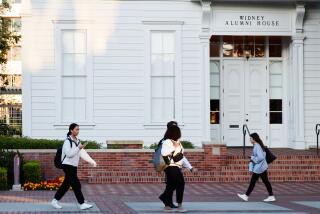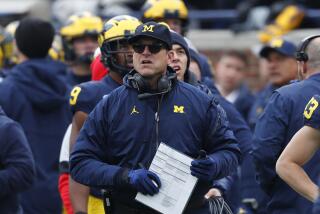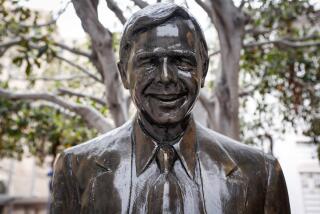Joe Paterno statue removed; NCAA to announce Penn State sanctions
- Share via
The statue of former football coach Joe Paterno was removed from the front of Penn State’s football stadium Sunday morning, a symbolic indication of how an icon in the university’s rich history had fallen in the wake of his inaction after revelations that his former assistant had sexually abused young boys.
But the more dramatic result in one of the more extreme cases in college football history may come Monday, when the NCAA will announce “corrective and punitive measures” against the university.
The NCAA gave no indication Sunday morning about the details, although at least two media outlets said that college sports’ governing body would not issue the so-called death penalty and shut down the football program.
Mark Emmert, NCAA president, refused to rule out that possibility in an interview on PBS last week, but ESPN and CNN, quoting unnamed sources, said that would not be the case Monday.
Emmert’s most memorable comment from the PBS interview was that he had “never seen anything as egregious” as the university’s handling of information about Jerry Sandusky’s repeated abuse.
The most well-known program to receive the NCAA death penalty was football at Southern Methodist University, which the NCAA suspended for the 1987 season because of extra-benefit violations; SMU did not play football the following year either.
The lack of institutional control is among the most severe violations in the eyes of the NCAA; it was cited in the organization’s harsh penalties levied against USC two years ago. USC was stripped of 30 football scholarships and held out of postseason play for two years, among other sanctions.
But Emmert in his PBS interview said, “This is completely different than an impermissible benefits scandal like [what] happened at SMU, or anything else we’ve dealt with.”
Meanwhile Sunday, the 7-foot statue of Paterno was lifted off its base and moved into Beaver Stadium. The Associated Press reported that 100 to 150 students watched and some chanted, “We are Penn State.” A number of people who watched the removal of the statue were angry.
There has been pressure on the university to remove the statue in the wake of the scandal, and additional pressure after the release of the Freeh Report that held Paterno and three top Penn State administrators accountable for failing to properly deal with such extraordinary cases of abuse.
The Paterno family, which has been vocal in defending the former coach — Paterno died in January — issued a statement decrying the statue decision.
The statue’s removal “does not serve the victims of Jerry Sandusky’s horrible crimes or help heal the Penn State community,” the statement said.
“We believe the only way to help the victims is to uncover the full truth,” said the family, which vowed its own investigation following the release of the report by former FBI director Louis Freeh.
The family called the report “the equivalent of an indictment — a charging document written by a prosecutor — and an incomplete and unofficial one at that.”
Construction vehicles and police arrived shortly after dawn Sunday, the AP reported, barricading the streets and sidewalks near the statue, erecting a chain-link fence and concealing the statue with a blue tarp. Workers then used jackhammers to free the statue and a forklift to lower it onto a flat-bed truck that rolled into a stadium garage bay about 100 feet away.
Paterno, in 46 seasons as head coach, won a major-college-record 409 games and was beloved by many in the Penn State community, which made the revelations in the Sandusky case all the more dramatic.
ALSO:
Penn State is being urged to shut down football program
Penn State University trustee member announces his resignation
Jerry Sandusky fallout: NCAA ‘death penalty’ for Penn State still a possibility
More to Read
Go beyond the scoreboard
Get the latest on L.A.'s teams in the daily Sports Report newsletter.
You may occasionally receive promotional content from the Los Angeles Times.











